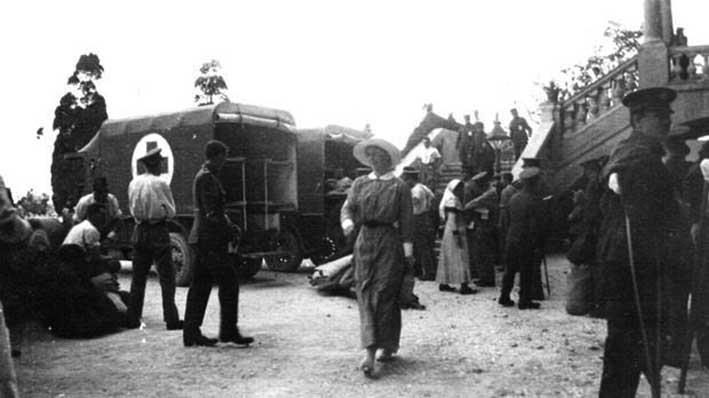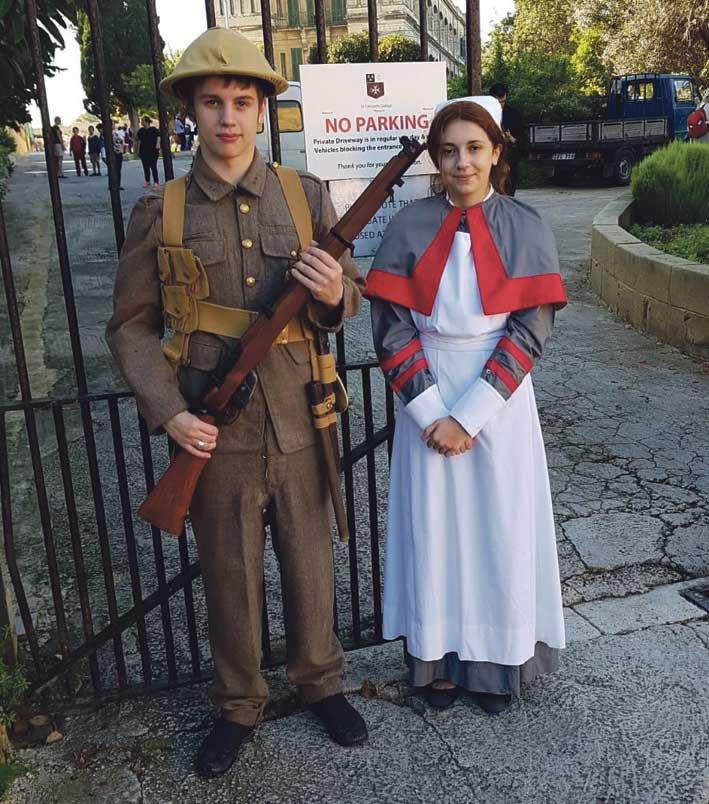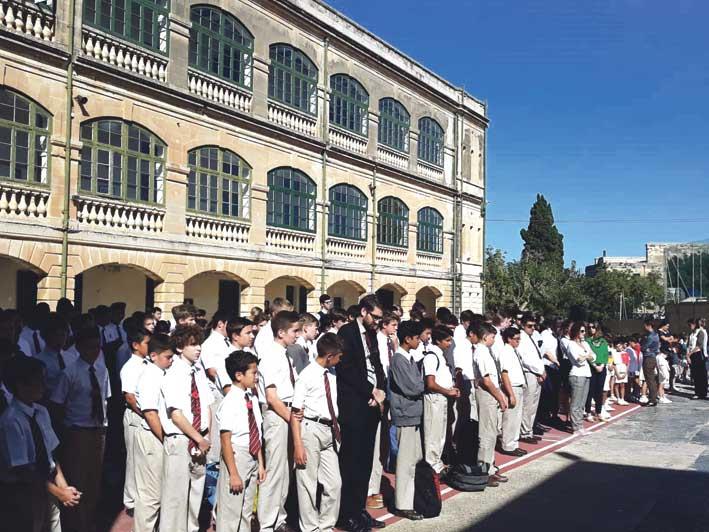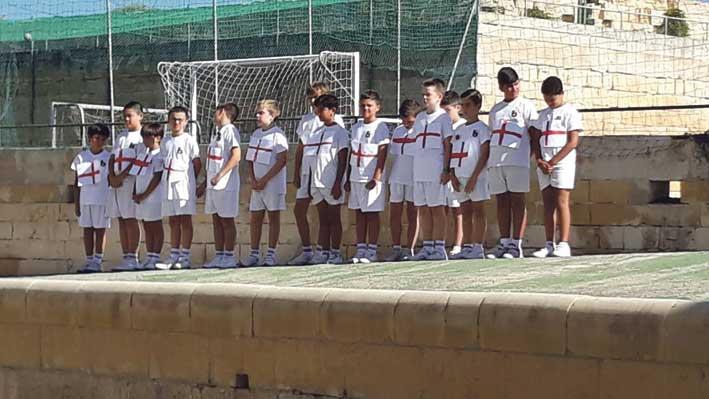A few weeks ago, I was invited to visit the First Word War Exhibition at St Edward's College, which was previously known as the Cottonera Hospital.
Cottonera Hospital was built in 1873 and at the time was considered to be one of the best in southern Europe. In 1929, the War Office leased it to accommodate St Edward's College.
My visit proved to be more than just another history tour, as the place is brimming with history.
Four years ago, the world commemorated the 100th anniversary of the commencement of the First World War. This war was dubbed 'The war to end all wars' due to the all-round carnage, disease and misery, and this year marks the 100th anniversary of the end of hostilities.

High on a vantage point on the Cottonera Bastions stands St Edward's College, enjoying vast picturesque views of the harbour and the surrounding countryside. Just a stone's throw away from Zabbar Gate (Notre Dame Gate) and the Cottonera Sports Complex, St Edward's College is particularly known for the service it provided during the First World War as a fully-fledged hospital and convalescent camp.
The site was initially developed by the Knights of St John as part of the defensive system protecting the outermost harbour region. Four canon emplacements still exist as a testimony of the fire-power this place afforded to any intruder threatening Malta's harbour inlets. The guns were never fired in anger, although they were fired - as warning shots - during the initial stages of the French Occupation.
The same site was also defended during the Second World War (1939-45) by means of a Bofors anti-aircraft position, when the college was occupied by the British military authorities. The staff and students were transferred to Mdina as refugees during this period.
In 1979, the college celebrated its 50th (Golden Jubilee) anniversary as a commemorative plaque unveiled by President Anton Buttigieg reveals. Before 1929, the building served as one of the most avant-garde hospitals in the Mediterranean.
The awareness raised by the research of Florence Nightingale, the founder of modern nursing who is known for her organised care of wounded soldiers in the Crimean War, brought to the surface the need for highly spacious and ventilated hospitals. She emphasised this need because her research had shown that most patients died from infectious diseases because they were confined in small areas in hospitals that were situated in densely populated areas. In fact, one aspect of St Edward's College that immediately strikes the eye is the number of apertures and verandas.

The place is honeycombed with very large wooden shutters and spacious verandas in order that the patients could have as much fresh air as possible during their recovery. These verandas also served as sleeping areas for the patients during the hot summer months. Graffiti, etched in stone by the patients, still exists as a testimony of the men who recovered there.
On the second floor of the building there is still one large ward that housed patients, the other wards having been divided to accommodate students when the hospital was converted into a college.
It is interesting to note that the policy embraced by the health authorities was also one where the least possible number of staff was to remain in the hospital at any one time. The reason being in line - there again - with Florence Nightingale's awareness that the more staff present, the greater the risk of cross-contamination. In fact, the building still has the Nurses Quarters and the Surgeons Quarters - the staff who were present at all times.

The effectiveness of the hospital came to its highest point during the First World War when it welcomed thousands of sick and wounded troops, mainly brought over from the Gallipoli Campaign. These were the ANZAC troops (Australian and New Zealanders). The recovery rate of the troops earned the hospital a very high reputation and proved Nightingale's recommendations correct.
It was not only ANZAC troops who received treatment at this hospital but also Prisoners of War (POWs) who were detained in internee camps mainly in the harbour area. In fact, one of the prominent POWs was Franz Joseph Prinz von Hohenzollern-Emden of the famous SMS Emden Light Cruiser. He was transferred to the hospital as it was just a short distance from Fort San Salvatore, where he was being detained. Despite being treated there, Franz Joseph made complaints directed at the Cottonera Hospital's facilities such as treatment by specialists was not to be procured even if the patients were prepared to pay for it. Other complaints included the treatment of the civilian prisoners, the post, the canteen, the medication, dental services and neutral representation for visiting and assessing the conditions of camps.
Ottoman POWs were also treated at the hospital, as evidenced by photographs at the Exhibition of St Edward's College. At one point, POWs were treated in a basement at the hospital but this practice was discontinued as being unsanitary and later they were housed in a gunpowder storehouse converted into an infirmary. The windows were only constructed in 1935, which is when the storeroom became the college's chapel.

The distinguishing features of the chapel are its very thick walls and the roof structure, specifically designed to cause the least damage in the event of a fire and/or explosion by lifting upwards rather than sideways. A short distance away from the hospital stood the convalescent camp of the hospital - on the site where the Cottonera Sports Complex now stands.
Another interesting feature of the college is the small but striking exhibition which was opened in 2014 by Prime Minister Joseph Muscat. The exhibition includes two impressive mannequins dressed in the uniforms of ANZAC (Australia New Zealand Ancillary Corps) infantrymen. The room housing the exhibition still has a wrought-iron fireplace and attractively decorated with photographs and the original 19th-century site plans of the hospital. It also contains original hospital stretchers and a bed with insect-netting and a adjustable, wooden head-rest, plus medicine chests containing medical paraphernalia.
One interesting painting - with its story - depicts the hospital ship HMHS Goorkha which hit a mine about 15 miles northeast of Malta in 1917 but did not sink and was towed back to shore having suffered no casualties. The hospital received 141 surgical cases from this ship.
One cannot omit to mention Ms Violet Briffa, a young nurse at Cottonera Hospital during the First World War who later became Matron of the College from 1930 to 1965.
For the writing of this feature, I would like to thank Prof. John M. Portelli, Old Edwardian and Chairman of the Board of Governors of St Edwards College, and Mr Albert Mamo, Old Edwardian and Member of the Board of Governors, for their kindness in inviting me to the college and giving me a tour around it.